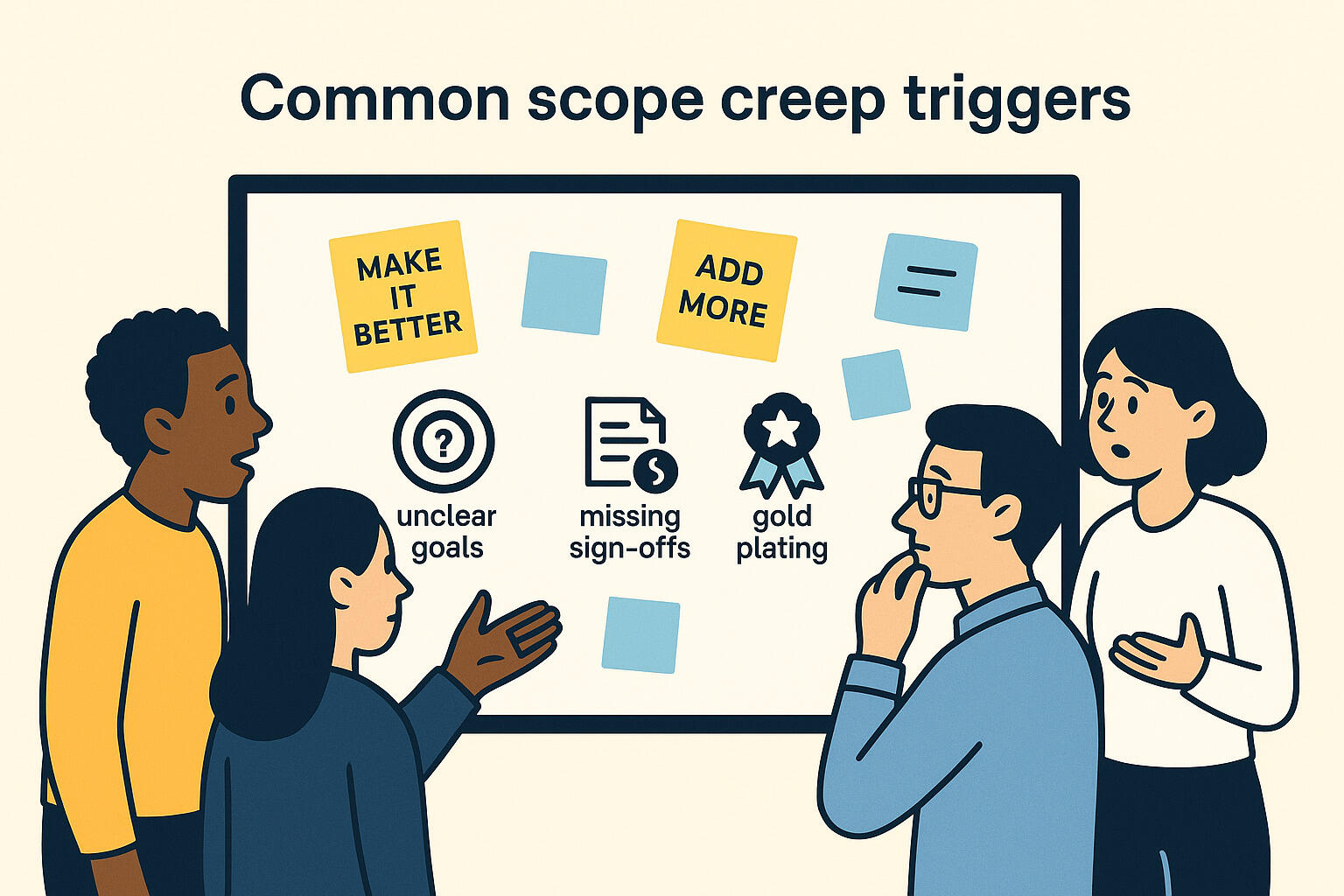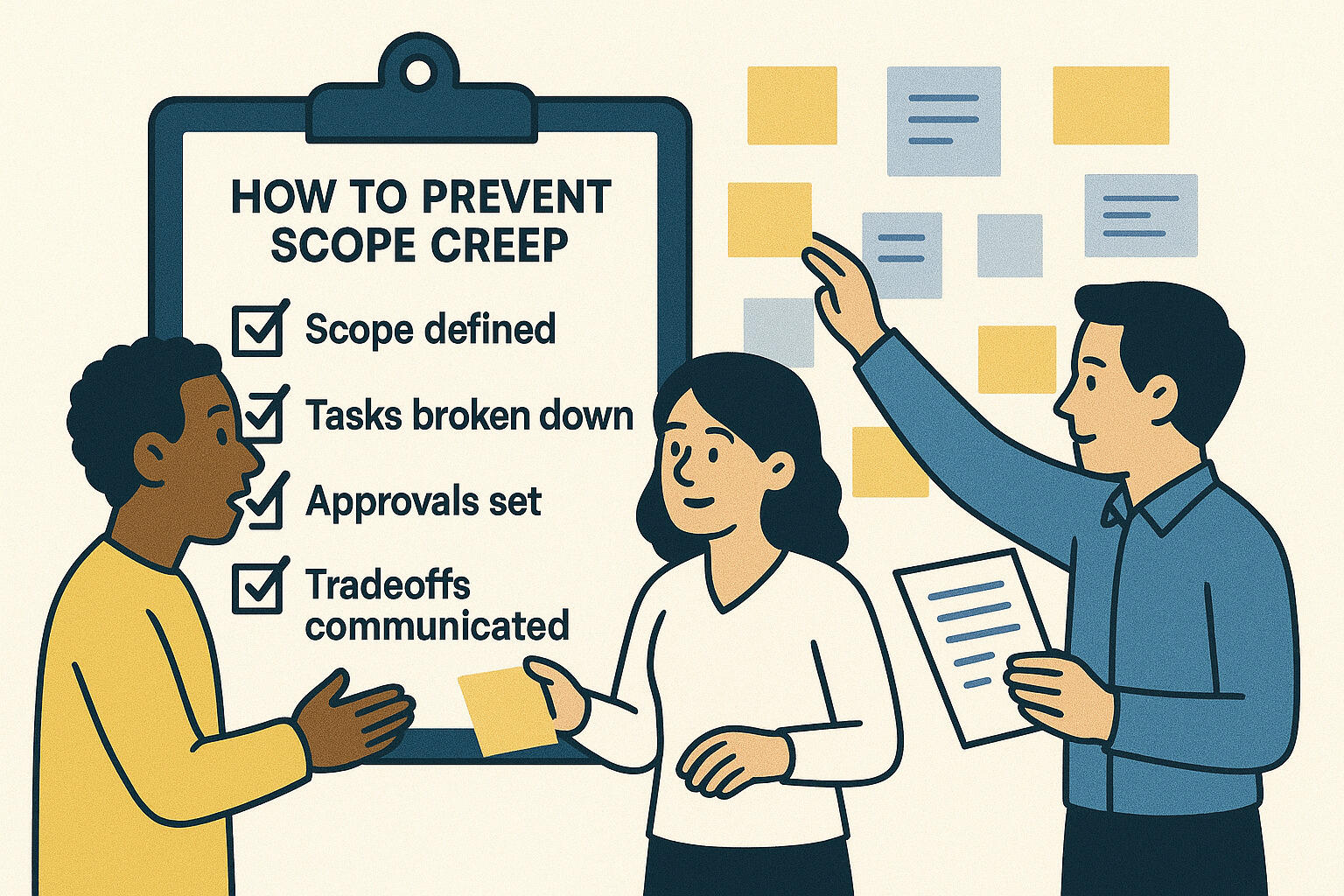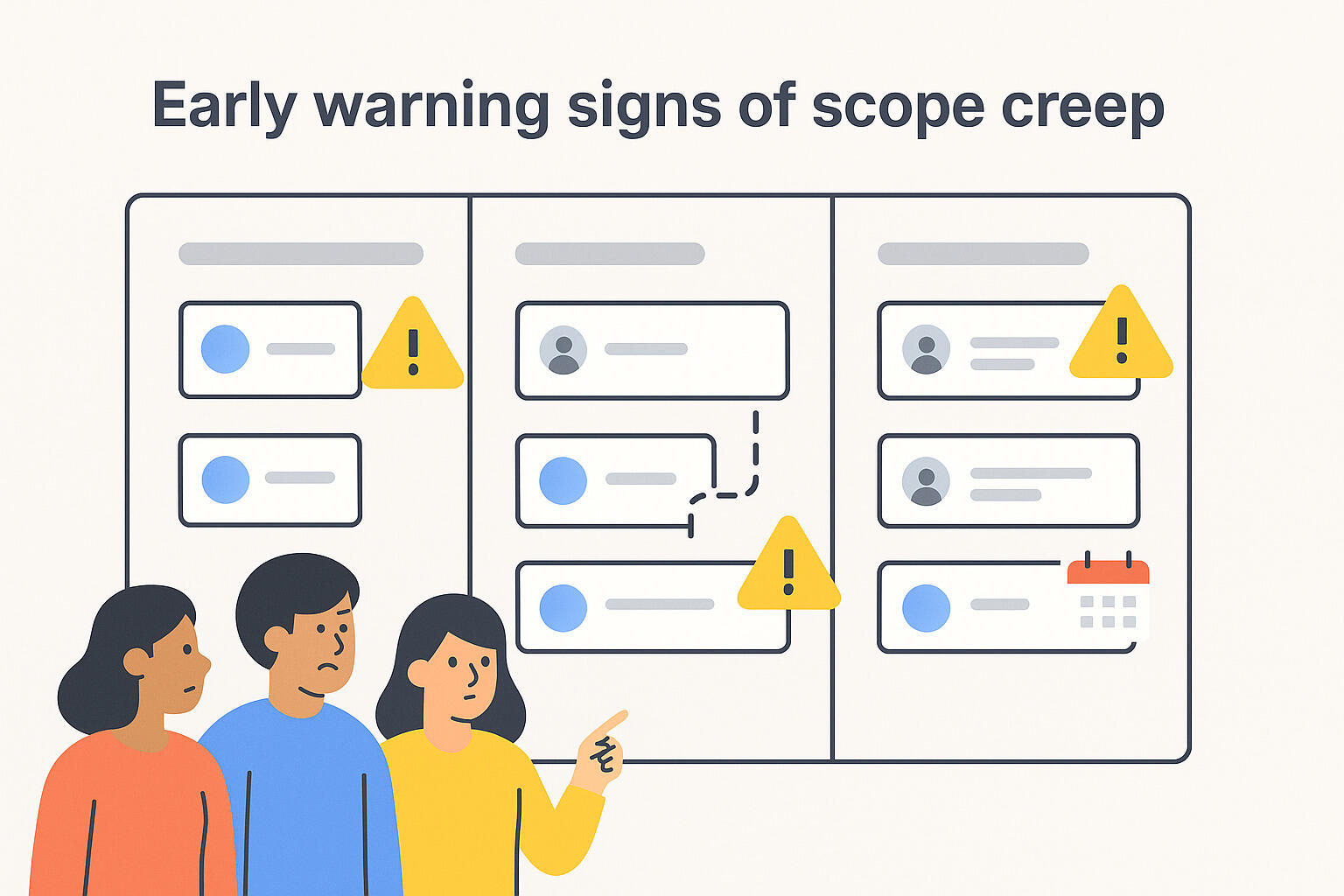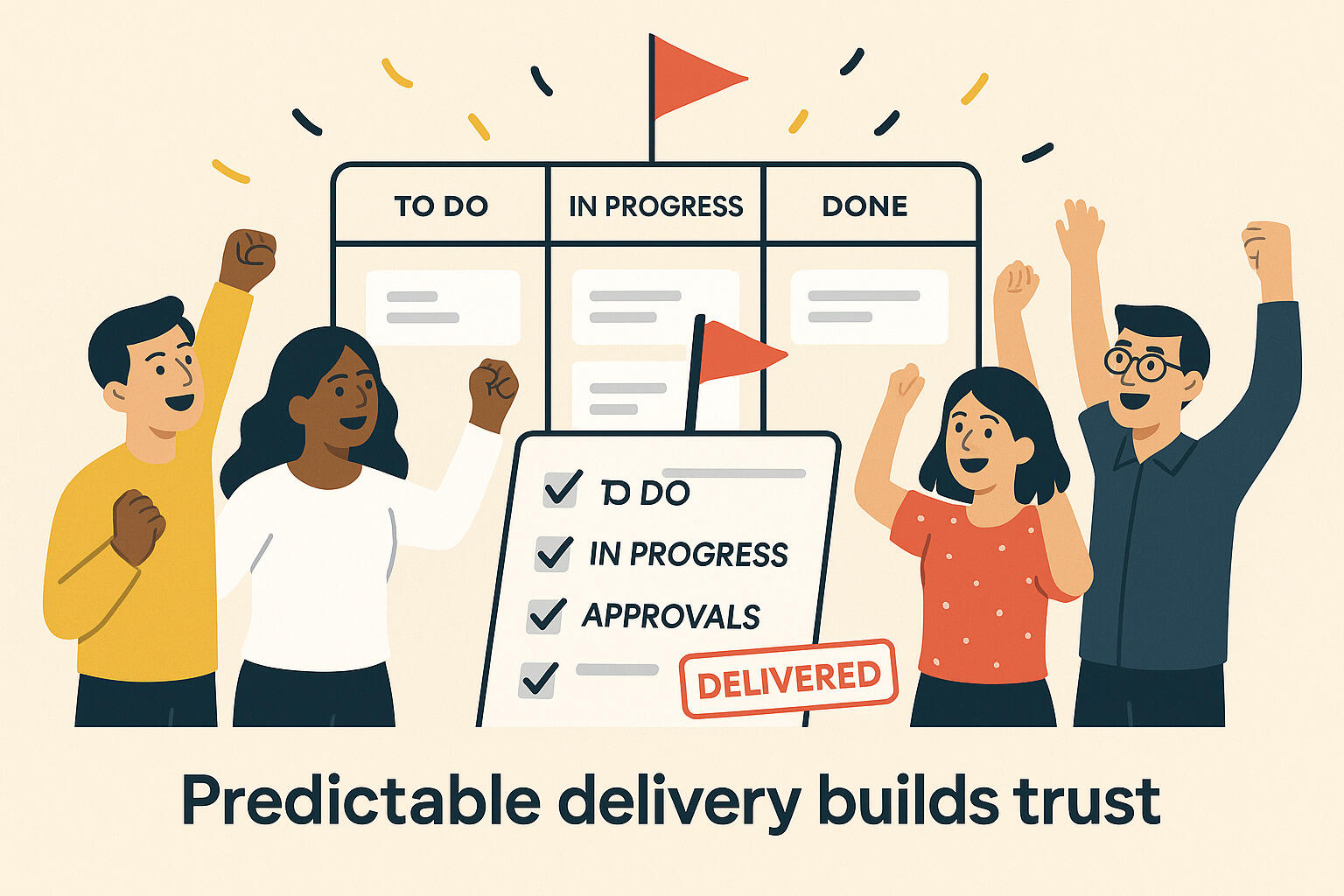Avoiding project scope creep: How to keep your work on track
Contents
Scope creep is one of the most common reasons projects run late, go over budget, or lose direction. Teams using Breeze have more visibility into what was agreed from the start, making it easier to manage changes before they become a problem. When extra features or tasks are added without structure, it disrupts the plan and slows everything down.

Many teams face shifting priorities, unclear input, or last-minute requests that sound helpful but cause rework and confusion. These situations are often well-intentioned, but without clear boundaries, they reduce focus and delay delivery.
That's why choosing the right project management tool matters. Breeze helps teams outline project scope clearly, track updates, and keep everyone aligned as work evolves. It's built for teams that need structure without getting slowed down by process. By managing scope more clearly, teams reduce stress and stay focused on delivering what matters.
1. What is scope creep and why does it happen?
Scope creep is when a project starts to grow beyond its original plan without formal review or approval. This usually means new tasks, extra features, or shifting deadlines that weren't agreed at the start. Over time, these changes make it harder to stay on schedule, control costs, or deliver the right results.
It often starts with small requests. On their own, changes might seem harmless. But when teams keep saying yes without checking the impact, projects begin to drift.
One major cause is unclear scope from the start. If no one agrees on what success looks like, it's easy to keep adding tasks without direction. Vague responsibilities or missing sign-offs also play a role. Without a clear process, changes get made informally and go untracked.
According to Quixy, 78 percent of projects that go over budget or miss deadlines are affected by scope changes that were not properly managed. Not all change is bad. Projects evolve. But teams need a way to assess new work before acting on it. A clear scope, shared process, and regular check-ins keep that growth in check.
2. Common triggers of scope creep
Scope creep rarely comes from one big change. It usually builds up through small decisions, vague requests, or missed approvals. Knowing the most common triggers helps teams catch these early and stay in control. Below are five key issues that lead to unmanaged scope expansion.

Unclear project goals
When a project starts without clear direction, teams often end up chasing shifting expectations. Without alignment on what success looks like, stakeholders may pull the work in different directions. Setting S.M.A.R.T. goals early helps avoid this. These goals add structure. With that clarity in place, it's easier to prioritize and reduce the rework needed
Vague client input
Ambiguous feedback, like “make it better” or “add a few more ideas,” leads to rework. Without clear requirements, teams keep revising tasks or features. This burns time and stretches resources without moving the project forward.
Overpromising
Saying yes to every request, especially without checking the impact on the timeline or budget, causes problems fast. What seems like a quick addition can ripple into delays and confusion later. Teams need a structure for evaluating new ideas before they accept them.
Missing sign-offs
Changes introduced without approval often pile up unnoticed. Without a formal checkpoint or documentation, teams may not realize how far they've drifted from the original plan. Getting decisions in writing and logging updates helps maintain scope.
Gold plating
Gold plating happens when team members go beyond what was asked, hoping to improve the result. While the intent is good, this can eat into budget and timelines without adding real value. Even well-meaning extras should be discussed, approved, and documented. Recognizing these patterns helps teams reduce rework and avoid unexpected shifts.
3. How to prevent scope creep before it starts
Scope creep is easier to prevent when the project starts with a structure. If the scope is clear, the team is more likely to stay focused and avoid distractions that slow delivery. But clear doesn't mean rigid. It means everyone agrees on what will be delivered, how it will be tracked, and what happens when something needs to change.
The first step is to define what the project includes. Use a simple scope document or a short brief that lists the main deliverables and goals. This gives your team and stakeholders a shared reference. It also makes it easier to spot new requests that fall outside the plan.

Once the scope is set, break down the work into smaller pieces. Define tasks and group them into phases. This helps show progress and makes it easier to adjust without losing track. Breeze makes this part simple. You can organize tasks in lists, assign team members, add due dates, and connect related work. Each change is easy to follow because it's documented and visible.
Set up a basic approval process for new requests. Teams don't need long review cycles, but they do need a habit of logging changes. If a stakeholder asks for something extra, pause and ask what it affects.
Be clear about tradeoffs. If something is added, something else might need to wait. The sooner this is communicated, the easier it is to keep the plan realistic. Scope creep often starts with small changes that seem harmless.
To recap, here's a quick checklist to avoid scope creep:
- Define the scope clearly with agreed-upon deliverables
- Break down work into tasks and phases
- Use a scope document or project brief
- Set up approval processes for new requests
- Communicate tradeoffs early when priorities shift
By doing these five things your team will have a better chance of staying on plan and adapting without confusion.
4. Managing change without losing control
Not all changes are bad. In fact, many are necessary. But without a system for managing them, even small requests can knock a project off track. The key is to handle change requests with care, structure, and visibility.
When a new request comes in, pause and review its impact. Will it affect timelines, budgets, or existing tasks? Who will need to be involved to make it happen? Don't commit until you've looked at what else the change might shift.
Next, log the request. This keeps it visible to everyone and avoids surprises later. In Breeze, you can add a change request as a new task, tag it for review, and link it to affected work. You can also comment directly on the item to start a discussion before it's approved.
Once you've reviewed and logged the change, confirm agreement. Make sure everyone understands what's changing and why. If a deadline moves or extra time is needed, document the update and adjust the project scope. Tasks can be moved across lists, re-prioritized, or given new deadlines without losing previous context.
Handling change well keeps projects flexible without becoming chaotic. It also shows clients and stakeholders that your team is responsive, but still focused.
5. Spotting the warning signs of scope creep
Scope creep rarely happens all at once. It builds gradually through missed signals that are easy to overlook. Watch for these early signs:
- Expanding task lists: Tasks keep appearing without discussion or clear reason, often beyond the original scope.
- Shifting priorities: Focus moves between unrelated items, making it harder for teams to stay aligned.
- Slipping deadlines: Due dates shift without explanation, often because of hidden changes or added work.
- Lack of context: Team members can't explain why certain tasks exist or how they support the project goals.
- Disconnected work: Tasks feel random or reactive, not tied to a shared plan or defined milestones.

In Breeze, you can catch these trends early using activity logs to track changes, labels to group tasks, and project views to spot unexpected growth. This gives teams a clearer view before small issues turn into real problems.
6. The cost of unmanaged scope changes
Scope creep tends to slip in quietly. A request to tweak a feature or add a “quick fix” can start a chain reaction. Without a clear process for approval and impact review, small extras pile up. Timelines shift, priorities blur, and teams lose focus.
When changes aren't tracked, even basic coordination becomes harder. Dependencies break, rework increases, and delivery slows down. Teams under pressure often push forward without revisiting scope, but the cost catches up later, in missed deadlines, overrun budgets, and rising stress.
According to the Project Management Institute, poor planning and weak task management waste nearly 12% of organizational resources. That includes the time lost to unmanaged changes and the added cost of unclear work. By controlling scope early and reviewing each change, teams avoid waste and build trust with clients.
7. Benefits of staying within scope
When teams stick to the agreed project scope, work becomes more predictable and easier to manage. Clear boundaries help avoid last-minute changes, reduce confusion, and keep priorities aligned. As a result, timelines are easier to meet, rework is minimized, and teams are less likely to lose momentum midway through delivery. Clients also benefit because they get exactly what was promised, which builds trust and improves satisfaction.
Staying within scope does not mean ignoring change. It means evaluating changes before acting on them. When scope is managed carefully, teams avoid rushing or compromising quality. Small additions, if approved and tracked, can improve results without derailing the plan. This approach keeps resources focused and supports a healthier pace of work, especially when timelines are tight or multiple projects run in parallel.

Some teams go even further and treat scope changes as opportunities. Managing new requests early allows them to uncover missed requirements or refine the outcome. This is the mindset behind turning scope creep into a scope creep advantage. Instead of reacting to shifting demands, teams stay in control using tools like Breeze, where changes are logged, reviewed, and tracked in real time. The more consistent the scope management, the fewer surprises teams face along the way.
8. Final thoughts
Preventing scope creep takes more than planning. It requires a clear workflow that shows what's included, what's changing, and who's responsible. Without visibility, small shifts go unnoticed until they create bigger problems.
Breeze makes it easier to manage projects by showing scope in real time, linking updates to tasks, and keeping everyone aligned. You can track what was approved, log new requests, and avoid losing sight of original goals.
If you want to keep your next project on track, start by mapping out the scope. Define the key deliverables, break the work into steps, and set clear limits. Then, organize the process and stay in control when changes come in.








